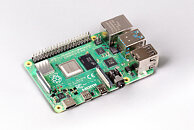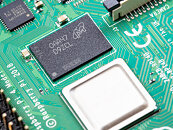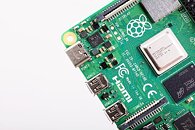Thursday, May 28th 2020
Raspberry Pi 4 Gets Upgraded to 8 GB, Priced at $75
Raspberry Pi 4 is almost a year old, and it's been a busy year. We've sold nearly 3 million units, shipped a couple of minor board revisions, and reduced the price of the 2 GB variant from $45 to $35. On the software side, we've done enormous amounts of work to reduce the idle and loaded power consumption of the device, passed OpenGL ES 3.1 conformance, started work on a Vulkan driver, and shipped PXE network boot mode and a prototype of USB mass storage boot mode - all this alongside the usual round of bug fixes, feature additions, and kernel version bumps.
While we launched with 1 GB, 2 GB and 4 GB variants, even at that point we had our eye on the possibility of an 8 GB Raspberry Pi 4. We were so enthusiastic about the idea that the non-existent product made its way into both the Beginner's Guide and the compliance leaflet. The BCM2711 chip that we use on Raspberry Pi 4 can address up to 16 GB of LPDDR4 SDRAM, so the real barrier to our offering a larger-memory variant was the lack of an 8 GB LPDDR4 package. These didn't exist (at least in a form that we could address) in 2019, but happily our partners at Micron stepped up earlier this year with a suitable part. And so, today, we're delighted to announce the immediate availability of the 8 GB Raspberry Pi 4, priced at just $75.It's worth reflecting for a moment on what a vast quantity of memory 8 GB really is. To put it in retro-perspective (retrospective?), this is a BBC Micro's worth of memory for every bit in the memory of the BBC Micro; it's a little over 13,000 times the 640 KB that Bill Gates supposedly thought should be enough for anyone (sadly, it looks as though this quote is apocryphal).
If you're a power user, intending to compile and link large pieces of software or run heavy server workloads, or you simply want to be able to have even more browser tabs open at once, this is definitely the Raspberry Pi for you.
What else has changed?
To supply the slightly higher peak currents required by the new memory package, James has shuffled the power supply components on the board, removing a switch-mode power supply from the right-hand side of the board next to the USB 2.0 sockets and adding a new switcher next to the USB-C power connnector. While this was a necessary change, it ended up costing us a three-month slip, as COVID-19 disrupted the supply of inductors from the Far East.Other than that, this is the same Raspberry Pi 4 you've come to know and love.
What about 64-bit?
Our default operating system image uses a 32-bit LPAE kernel and a 32-bit userland. This allows multiple processes to share all 8 GB of memory, subject to the restriction that no single process can use more than 3 GB. For most users this isn't a serious restriction, particularly since every tab in Chromium gets its own process. Sticking with a 32-bit userland has the benefit that the same image will run on every board from a 2011-era alpha board to today's shiny new 8 GB product.
But power users, who want to be able to map all 8 GB into the address space of a single process, need a 64-bit userland. There are plenty of options already out there, including Ubuntu and Gentoo.
Not to be left out, today we've released an early beta of our own 64-bit operating system image. This contains the same set of applications and the same desktop environment that you'll find in our regular 32-bit image, but built against the Debian arm64 port.
Both our 32-bit and 64-bit operating system images have a new name: Raspberry Pi OS. As our community grows, we want to make sure it's as easy as possible for new users to find our recommended operating system for Raspberry Pi. We think the new name will help more people feel confident in using our computers and our software. An update to the Raspberry Pi Desktop for all our operating system images is also out today, and we'll have more on that in tomorrow's blog post.
You can find a link to the new 64-bit image, and some important caveats, in this forum post.
While we launched with 1 GB, 2 GB and 4 GB variants, even at that point we had our eye on the possibility of an 8 GB Raspberry Pi 4. We were so enthusiastic about the idea that the non-existent product made its way into both the Beginner's Guide and the compliance leaflet. The BCM2711 chip that we use on Raspberry Pi 4 can address up to 16 GB of LPDDR4 SDRAM, so the real barrier to our offering a larger-memory variant was the lack of an 8 GB LPDDR4 package. These didn't exist (at least in a form that we could address) in 2019, but happily our partners at Micron stepped up earlier this year with a suitable part. And so, today, we're delighted to announce the immediate availability of the 8 GB Raspberry Pi 4, priced at just $75.It's worth reflecting for a moment on what a vast quantity of memory 8 GB really is. To put it in retro-perspective (retrospective?), this is a BBC Micro's worth of memory for every bit in the memory of the BBC Micro; it's a little over 13,000 times the 640 KB that Bill Gates supposedly thought should be enough for anyone (sadly, it looks as though this quote is apocryphal).
If you're a power user, intending to compile and link large pieces of software or run heavy server workloads, or you simply want to be able to have even more browser tabs open at once, this is definitely the Raspberry Pi for you.
What else has changed?
To supply the slightly higher peak currents required by the new memory package, James has shuffled the power supply components on the board, removing a switch-mode power supply from the right-hand side of the board next to the USB 2.0 sockets and adding a new switcher next to the USB-C power connnector. While this was a necessary change, it ended up costing us a three-month slip, as COVID-19 disrupted the supply of inductors from the Far East.Other than that, this is the same Raspberry Pi 4 you've come to know and love.
What about 64-bit?
Our default operating system image uses a 32-bit LPAE kernel and a 32-bit userland. This allows multiple processes to share all 8 GB of memory, subject to the restriction that no single process can use more than 3 GB. For most users this isn't a serious restriction, particularly since every tab in Chromium gets its own process. Sticking with a 32-bit userland has the benefit that the same image will run on every board from a 2011-era alpha board to today's shiny new 8 GB product.
But power users, who want to be able to map all 8 GB into the address space of a single process, need a 64-bit userland. There are plenty of options already out there, including Ubuntu and Gentoo.
Not to be left out, today we've released an early beta of our own 64-bit operating system image. This contains the same set of applications and the same desktop environment that you'll find in our regular 32-bit image, but built against the Debian arm64 port.
Both our 32-bit and 64-bit operating system images have a new name: Raspberry Pi OS. As our community grows, we want to make sure it's as easy as possible for new users to find our recommended operating system for Raspberry Pi. We think the new name will help more people feel confident in using our computers and our software. An update to the Raspberry Pi Desktop for all our operating system images is also out today, and we'll have more on that in tomorrow's blog post.
You can find a link to the new 64-bit image, and some important caveats, in this forum post.



18 Comments on Raspberry Pi 4 Gets Upgraded to 8 GB, Priced at $75
www2.mouser.com/ProductDetail/Micron/MT53E2G32D4NQ-046-WTA?qs=wnTfsH77Xs4X8jDmtbVXBw%3D%3D
Also, don't compare ARM and x86 CPU memory design, as it's a bit more complicated than single and dual channel.
PC DIMMs use a 64-bit bus width, whereas in this case, at least based on the memory chip used, it looks like the RPi is only using a 32-bit memory bus.
Many ARM based processors still only use a 16-bit bus on the lower end. Others use some very odd layouts like 4x 16-bit (Samsung Exynos for example), whereas 2x 32-bit is also quite common. This is also why you can't use PC SO-DIMMs or DIMMs with most ARM SoCs.
I'm still tinkering with a bunch of old 1st gen RPi B+ and have turned them into cctv cameras around my house for my homemade surveillance system. I've also got a RPi 3B with the official RPi 7" touchscreen and use them as a monitor/controller for the above system.
I was thinking about getting a RPi 4B to play with. 8GB might be overkill for it, but I think I'll get this one.
en.wikipedia.org/wiki/VideoCore
I've got the 4GB version and I use it as a NAS. Right now, it says it's only using 245MB out of the 4GB. Which is surprisingly little.
Better off getting an Amazon Fire TV Stick 4K, although I learn the hard way that the Prime Video app doesn't work outside the region you bought the stick in :kookoo:
Apart from that it works pretty well and I only paid $25 for it and it's not otherwise available where I live so...
Most of the video content we stream cannot be done through an app, and the Smart TV is actually pretty zippy with Netflix and all.
Odroid XU4
www.hardkernel.com/shop/odroid-xu4-special-price/
www.hardkernel.com/shop/odroid-xu4q-special-price/
The newest Odroid board, the C4;
www.hardkernel.com/shop/odroid-c4/
Odroid also has an X86 based SBC which will run Windows in addition to Linux and Android;
www.hardkernel.com/shop/odroid-n2-with-4gbyte-ram/
RaspberryPi is very well supported, but is weak in the hardware department. Odroid's offerings are also very well supported but aim at high performance.
If all else fails I'm just going to stick an Intel NUC behind the TV, but prefer to keep money in pocket :P
I'm not using RAID. And the filesystem I use (btrfs) has checksums so I should be able to detect data errors if there are any. There have been no errors yet. I also have backups of all my data.
USB connected drives are obviously fine for what they've been designed for, but a lot of the drive manufacturers put their cheaper tier of hard drives in external drives as well.
But I'm actually being super careful. Here's the all the precautions I took:
- I have a backup (and all the important data has multiple backups)
- the original copy of the data is not on the NAS but actually on my desktop (in most cases)
- I use a checksumming filesystem on the NAS which should catch file errors
- I got a WD Elements 8TB as the external drive. It has the WD80EMAZ drive which should be decent quality.
I believe if you manage the risks, a raspberry pi 4 NAS can be useful.